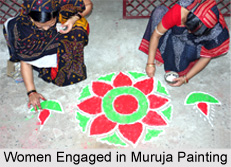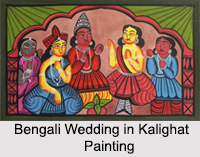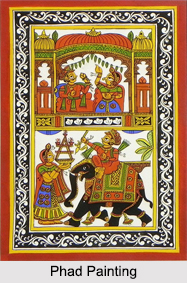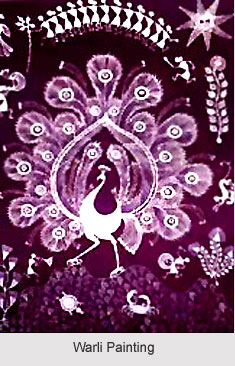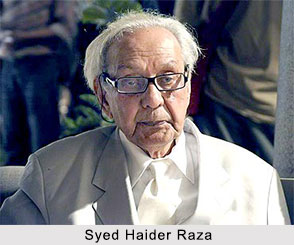 Syed Haider Raza alias S. H. Raza was an internationally acclaimed modern Indian painter, whose works prominently included abstracts in oil or acrylic, with a very rich use of colour, replete with icons from Indian cosmology as well as its philosophy. He was recognised with the Padma Shri and Fellowship of the Lalit Kala Akademi in 1981, while being later honoured with the Padma Bhushan in 2007. The Indian Government also honoured him with Padma Vibhushan, the country"s second highest civilian award in 2013 and the artist was also conferred the highest civilian honour of France, Commandeur de la Legion d`honneur (Legion of Honour) on July 14, 2015. He had lived and worked in France since 1950, all the while maintaining strong ties with India.
Syed Haider Raza alias S. H. Raza was an internationally acclaimed modern Indian painter, whose works prominently included abstracts in oil or acrylic, with a very rich use of colour, replete with icons from Indian cosmology as well as its philosophy. He was recognised with the Padma Shri and Fellowship of the Lalit Kala Akademi in 1981, while being later honoured with the Padma Bhushan in 2007. The Indian Government also honoured him with Padma Vibhushan, the country"s second highest civilian award in 2013 and the artist was also conferred the highest civilian honour of France, Commandeur de la Legion d`honneur (Legion of Honour) on July 14, 2015. He had lived and worked in France since 1950, all the while maintaining strong ties with India.
S. H. Raza became one of India`s priciest modern artists on June 10, 2010, when a seminal work "Saurashtra" by the 88-year-old was sold for Rs.16.42 crores (USD 3,486,965) at a Christie`s auction. In 1959, he married the French artist Janine Mongillat, who died in 2002 of cancer, after which he decided to return to India. The painter breathed his last on July 23, 2016 in New Delhi, after a prolonged illness, aged 94.
Early Life and Education of Syed Haider Raza
Syed Haider Raza was born on February 22, 1922 in Babaria, coming under erstwhile Central Provinces and Berar of British India, present day Mandla District of Madhya Pradesh. His father, Sayed Mohammed Razi, was the Deputy Forest Ranger of the district and his mother was Tahira Begum. He spent his early years there and took to drawing at the age of 12. At 13, he moved to Damoh, also in the state, where he completed his schooling from Government High School. Thereafter, he studied at the Nagpur School of Art in Nagpur (from 1939 to 1943), followed by Sir J. J. School of Art in Bombay (from 1943 to 1947), before moving to France in October 1950 to study at the Ecole nationale superieure des Beaux-Arts (ENSB-A) in Paris, from 1950 to 1953 on a Government of France scholarship. After his studies, he continued to live in France, exhibiting his works in Paris and also travelling across Europe. He was later awarded the Prix de la critique in Paris in 1956, becoming the first non-French artist to receive the honour.
Art Career of Syed Haider Raza
Syed Haider Raza had his first solo show in the year 1946, at Bombay Art Society Salon, and was awarded the Silver Medal of the society. He initially painted expressionistic landscapes and later on evolved to concentrating on abstract themes. From the fluent water colours of landscapes and townscapes he executed in the early 1940s, he moved to conveying more expressive language, painting landscapes of the mind.
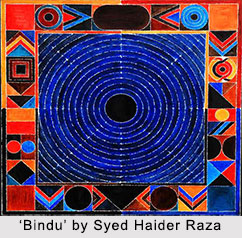 The year 1947 was an eventful year for S. H. Raza, when his mother passed away and he co-founded the revolutionary Bombay Progressive Artists` Group (1947-1956), along with K. H. Ara and F. N. Souza. This group set out to break free from the influences of European realism in Indian art and bring the Indian inner vision ("Antar gyan") into their art. The group had its first show in 1948, the same year where Raza"s father died in Mandla. Post the partition of India, most of his siblings migrated to Pakistan.
The year 1947 was an eventful year for S. H. Raza, when his mother passed away and he co-founded the revolutionary Bombay Progressive Artists` Group (1947-1956), along with K. H. Ara and F. N. Souza. This group set out to break free from the influences of European realism in Indian art and bring the Indian inner vision ("Antar gyan") into their art. The group had its first show in 1948, the same year where Raza"s father died in Mandla. Post the partition of India, most of his siblings migrated to Pakistan.
Once in France, Raza continued experimenting with the currents of Western Modernism, moving from expressionist modes towards greater abstraction, and eventually incorporating elements of Tantrism from Indian scriptures. While his fellow contemporaries dealt with more figural subjects, Raza chose to focus on landscapes in the 1940s and 50s, inspired partly by moving to France. In 1962, he became a visiting lecturer at the University of California in Berkeley, USA. Raza was initially enamoured by the pastoral countryside of rural France. "Eglise" is part of a series which captures the rolling terrain and quaint village architecture of this region. Depicting a tumultuous church engulfed by an inky blue night sky, Raza uses gestural brushstrokes and a heavily impasto-ed application of paint, stylistic devices that hint at his later 1970s abstractions.
By the 1970s, S. H. Raza had become increasingly unhappy and restless about his own work and wanted to find a new direction and deeper authenticity, and move away from the "plastic art". His trips to India, to the caves of Ajanta & Ellora, followed by those to Benaras, Gujarat and Rajasthan, made him realise his role and study Indian culture more closely, and this crystallised in the "Bindu". "Bindu" (referring to a point or the source of energy) came forth in 1980 and signified his rebirth as a painter, taking his work deeper and bringing in his new-found Indian vision and Indian ethnography. One of the reasons he credits to the genesis of the `Bindu` is his elementary school teacher, who on finding him lacking adequate concentration, used to draw a dot on the blackboard and asked him to concentrate on it. Post "Bindu", the artist added newer dimensions to his thematic compositions in the subsequent decades, which incorporated themes around the "Tribhuj" (Triangle) which supported Indian concepts of space and time, as well as that of "prakriti-purusha" (the female and the male energy), his transformation from an expressionist to a master of abstraction and profundity was therefore complete.
The unique energy vibrating with colour which was visible in his early landscapes had become more subtle and more dynamic. In the year 2000, the artist"s calibre and finesse took another leap, as he began to express his increasingly deepened insights and thoughts on Indian spirituality and created works around the Kundalini, the Nagas and the Mahabharata.
S. H. Raza`s works represent the origins of life and symbols which tribal painters and highly sophisticated Indian philosophers have drawn, pondered and mulled over for years. His works vibrate like modern Tantric "tankhas" inducing wonder, joy and meditation within the viewer. His Indian canvases and the early French ones were all realistic. His primary colours of fire and the sea are the colours of outer space, dark blue and yellow incorporated wherever light becomes material. As the master artist himself puts, "My work is my own inner experience and involvement with the mysteries of nature and form which is expressed in colour, line, space and light".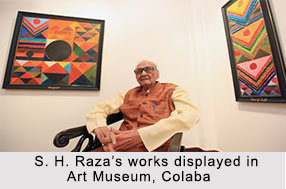
Other Contributions by Syed Haider Raza
S. H. Raza had also founded Raza Foundation in India for promotion of art among Indian youth, which also gives away Annual Raza Foundation Award to young artists in India.
Exhibitions displaying works of Syed Haider Raza
The works of S. H. Raza have seen showcase in the following galleries and exhibitions:
•Flora Jansem Gallery, Raza Ceramiques, Paris (2010)
•Akar Prakar Art Gallery in Kolkata, Ahmedabad, Jaipur and Delhi (2010)
•Exhibition Magnificent Seven at Art Alive Gallery, Delhi (2008)
•Jehangir Art Gallery, Mumbai (1997)
•National Gallery of Modern Art, New Delhi (1997)
•The Art Rental Corporate, Group Michael Ferrier, Echirolles, Grenoble (1994)
•Jehangir Nicholson Museum, National Centre for Performing Arts, Mumbai (1992)
•Courses Arts Lalouvesc, France (1992)
•Museum of Menton, France (1991)
•Galerie Pierre Parat, Paris (1985)
•Chemould Gallery, Bombay (1984)
•Gallery Loeb, Bern, Switzerland (1982)
Awards and Honours received by Syed Haider Raza
Syed Haider Raza had been recognised with the given awards and honours in his lifetime.
•Silver Medal, Bombay Art Society, Mumbai (1946)
•Gold Medal, Bombay Art Society, Mumbai (1948)
•Prix de la critique, Paris (1956)
•Padma Shri by the Government of India (1981)
•Fellowship of Lalit Kala Akademi, New Delhi (1981)
•Kalidas Samman by Government of Madhya Pradesh (1981)
•Padma Bhushan by the Government of India (2007)
•Padma Vibhushan by the Government of India (2013)
•Commandeur de la Legion d"Honneur (Legion of Honour) by Government of France (2015)
Related Articles:
Indian Painters
Indian Cosmology
Indian Philosophy
Indian Paintings
Indian Tribal Paintings

